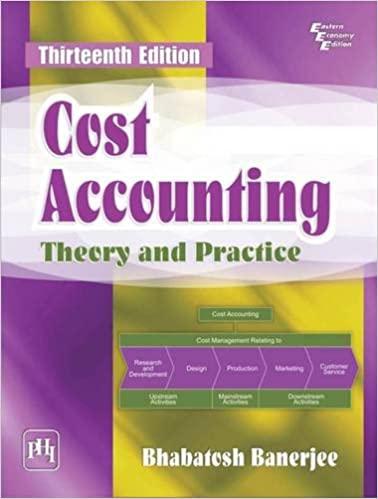Answered step by step
Verified Expert Solution
Question
1 Approved Answer
PET Plugress Vaughn Company makes swimsuits and sells these suits directly to retailers. Although Vaughn has a variety of suits, it does not make the




PET Plugress Vaughn Company makes swimsuits and sells these suits directly to retailers. Although Vaughn has a variety of suits, it does not make the All-Body suit used by highly skilled swimmers. The market research department believes that a strong market exists for this type of suit. The department indicates that the All-Body suit would sell for approximately $100. Given its experience, Vaughn believes the All-Body suit would have the following manufacturing costs. $29 29 Direct materials Direct labor Manufacturing overhead Total costs 42 $100 (a1) Assume that Vaughn uses cost-plus pricing, setting the selling price 26% above its costs. What would be the price charged for the All-Body swimsuit? Selling price $ thook and Concord Small Engine Repair charges $46 per hour of labor. It has a material loading percentage of 39%. On a recent job replacing the engine of a riding lawnmower, Concord worked 11.5 hours and used parts with a cost of $900. Calculate Concord's total bill. Concord's total bill Crane Cheese Company has developed a new cheese slicer called Slim Slicer. The company plans to sell this slicer through its catalog, which it issues monthly. Given market research, Crane believes that it can charge $30 for the Slim Slicer. Prototypes of the Slim Slicer, however, are costing $32. By using cheaper materials and gaining efficiencies in mass production, Crane believes it can reduce Slim Slicer's cost substantially. Crane wishes to earn a return of 40% of the selling price. (a) Compute the target cost for the Slim Slicer. Target cost $ Crane Corporation produces snowboards. The following per unit cost information is available: direct materials $10, direct labor $4, variable manufacturing overhead $3, fixed manufacturing overhead $10, variable selling and administrative expenses $1, and fixed selling and administrative expenses $8. Using a 25% markup percentage on total per unit cost, compute the target selling price. (Round answer to 2 decimal places, eg. 10.50.) Target selling price $
Step by Step Solution
There are 3 Steps involved in it
Step: 1

Get Instant Access to Expert-Tailored Solutions
See step-by-step solutions with expert insights and AI powered tools for academic success
Step: 2

Step: 3

Ace Your Homework with AI
Get the answers you need in no time with our AI-driven, step-by-step assistance
Get Started


